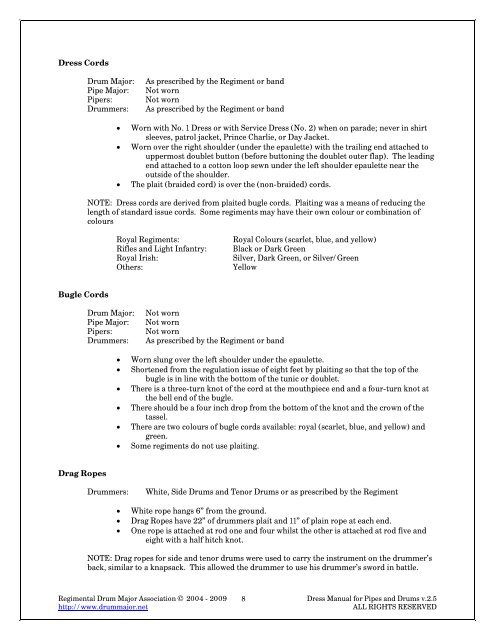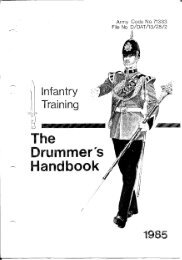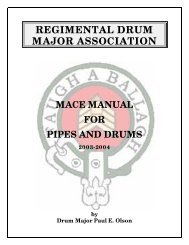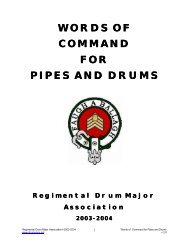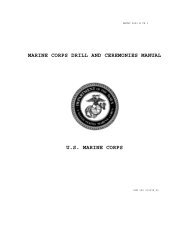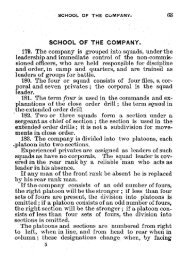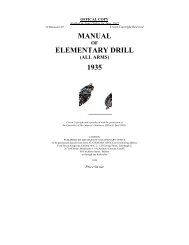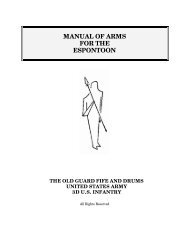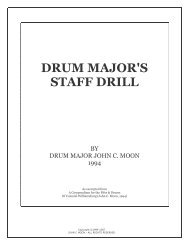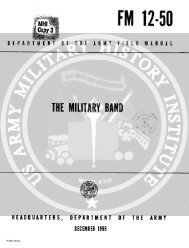RDMA Dress Manual - Regimental Drum Major Association
RDMA Dress Manual - Regimental Drum Major Association
RDMA Dress Manual - Regimental Drum Major Association
Create successful ePaper yourself
Turn your PDF publications into a flip-book with our unique Google optimized e-Paper software.
<strong>Dress</strong> Cords<br />
Bugle Cords<br />
Drag Ropes<br />
<strong>Drum</strong> <strong>Major</strong>: As prescribed by the Regiment or band<br />
Pipe <strong>Major</strong>: Not worn<br />
Pipers: Not worn<br />
<strong>Drum</strong>mers: As prescribed by the Regiment or band<br />
• Worn with No. 1 <strong>Dress</strong> or with Service <strong>Dress</strong> (No. 2) when on parade; never in shirt<br />
sleeves, patrol jacket, Prince Charlie, or Day Jacket.<br />
• Worn over the right shoulder (under the epaulette) with the trailing end attached to<br />
uppermost doublet button (before buttoning the doublet outer flap). The leading<br />
end attached to a cotton loop sewn under the left shoulder epaulette near the<br />
outside of the shoulder.<br />
• The plait (braided cord) is over the (non-braided) cords.<br />
NOTE: <strong>Dress</strong> cords are derived from plaited bugle cords. Plaiting was a means of reducing the<br />
length of standard issue cords. Some regiments may have their own colour or combination of<br />
colours<br />
Royal Regiments: Royal Colours (scarlet, blue, and yellow)<br />
Rifles and Light Infantry: Black or Dark Green<br />
Royal Irish: Silver, Dark Green, or Silver/Green<br />
Others: Yellow<br />
<strong>Drum</strong> <strong>Major</strong>: Not worn<br />
Pipe <strong>Major</strong>: Not worn<br />
Pipers: Not worn<br />
<strong>Drum</strong>mers: As prescribed by the Regiment or band<br />
• Worn slung over the left shoulder under the epaulette.<br />
• Shortened from the regulation issue of eight feet by plaiting so that the top of the<br />
bugle is in line with the bottom of the tunic or doublet.<br />
• There is a three-turn knot of the cord at the mouthpiece end and a four-turn knot at<br />
the bell end of the bugle.<br />
• There should be a four inch drop from the bottom of the knot and the crown of the<br />
tassel.<br />
• There are two colours of bugle cords available: royal (scarlet, blue, and yellow) and<br />
green.<br />
• Some regiments do not use plaiting.<br />
<strong>Drum</strong>mers: White, Side <strong>Drum</strong>s and Tenor <strong>Drum</strong>s or as prescribed by the Regiment<br />
• White rope hangs 6” from the ground.<br />
• Drag Ropes have 22” of drummers plait and 11” of plain rope at each end.<br />
• One rope is attached at rod one and four whilst the other is attached at rod five and<br />
eight with a half hitch knot.<br />
NOTE: Drag ropes for side and tenor drums were used to carry the instrument on the drummer’s<br />
back, similar to a knapsack. This allowed the drummer to use his drummer’s sword in battle.<br />
<strong>Regimental</strong> <strong>Drum</strong> <strong>Major</strong> <strong>Association</strong> © 2004 - 2009 8<br />
<strong>Dress</strong> <strong>Manual</strong> for Pipes and <strong>Drum</strong>s v.2.5<br />
http://www.drummajor.net ALL RIGHTS RESERVED


